Spotlight on Meryl Schenker
Jan 22, 2013
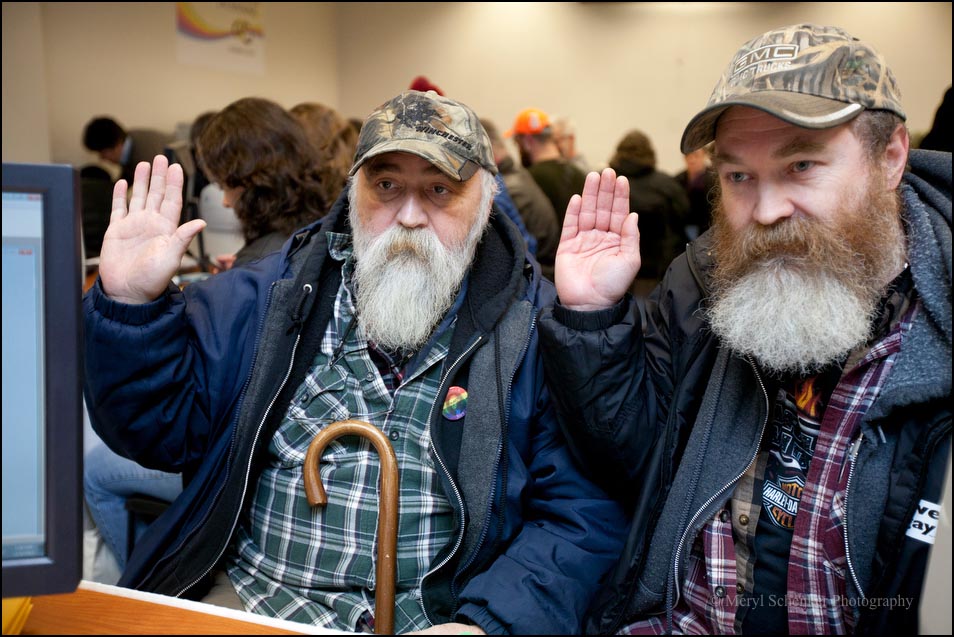
TID:
This image quickly “went viral” on the Internet and really struck a chord with people when same-sex marriage was legalized in Washington State. Please tell us the backstory behind the image.
MERYL:
On February 13, 2012, Governor Chris Gregoire signed a bill legalizing same-sex marriage in Washington State. However, due to the referendum process, the issue was then put on the ballot for voters to decide. After the November 6th election, and for the first time in history, same-sex marriage became legal by a vote of the people and the result was certified on December 5th.
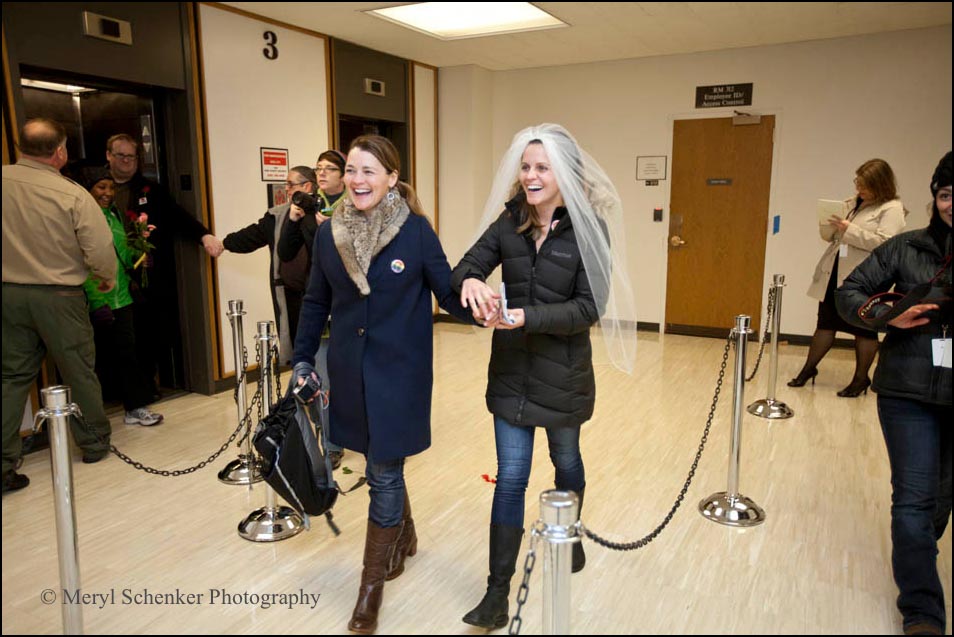
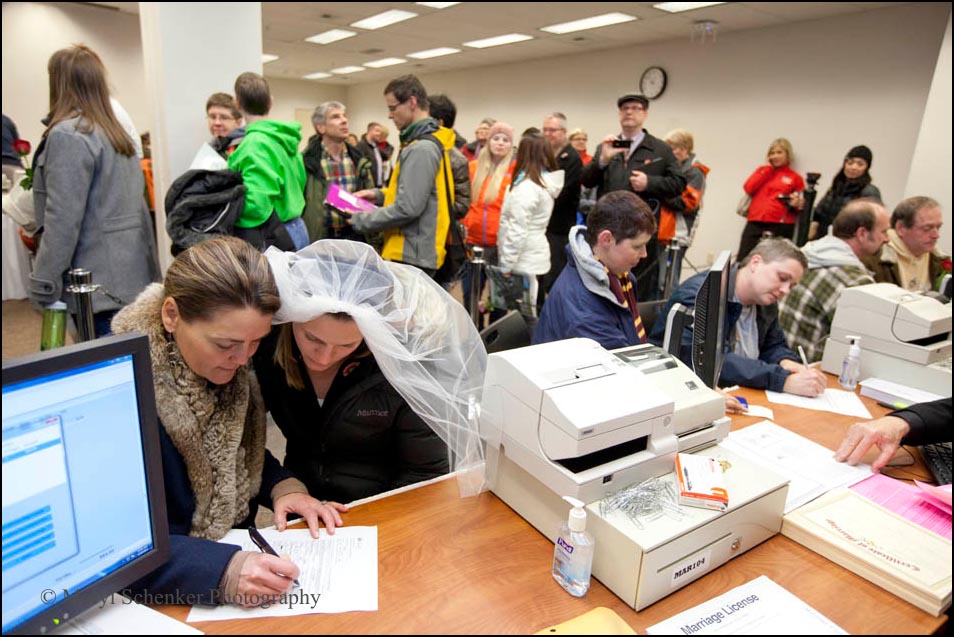
That evening people began lining up to apply for marriage licenses and shortly after midnight on December 6th, 2012, the first licenses were issued. There were 10 couples, many of whom had a hand in the passage of the referendum, who in a small ceremony (with their guests and the media present) obtained their licenses from King County Executive Dow Constantine. Simultaneously, people who had lined up outside, were let into the King County Recorder’s Office to obtain their marriage licenses. Randy and Larry were number 72.
TID:
How did you prepare for this story?
MERYL:
I honestly didn’t prepare, and I almost didn’t go.
After working all day, I had two photography sessions for my business, Meryl Schenker Photography, and getting caught up in a traffic jam, I was tired. In addition, I couldn’t really envision what type of photos I would be able to make if I went. I’ve never applied for a marriage license, so I had no idea what that looked like visually. I was having a difficult time getting motivated. Furthermore, it was originally determined the private midnight ceremony was going to be a pool situation, so I wasn’t planning on being let into that event.
At the last minute, I decided to go and see what I could see. I knew I’d at least get my friend and client, Jessica and her fiance, Lisa, getting their marriage license, as I knew they were waiting in line. I really didn’t want to miss the opportunity to document history. Besides, in the past, none of my best images were conceptualized in advance.
TID:
There were dozens of other photographers there to document this historic moment. How did you place yourself in the right place at the right time?
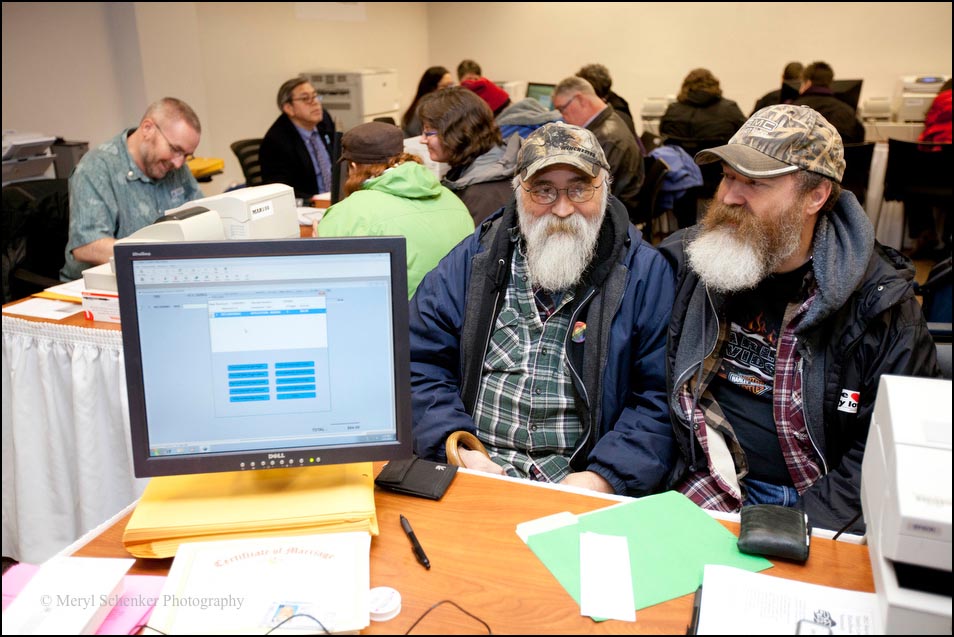
MERYL:
I try and stay later than everyone else and get away from other photographers. Sometimes it’s just not possible, but for a moment in time at 1:30 a.m., it was. Plus a little bit of luck is always involved. It was late, and a lot of my colleagues were either transmitting by then, downstairs where the couples were leaving, or had left.
Because I wasn’t working for a daily or wire service, I didn’t try to make any deadlines, just concentrate on the image making. I know I could have had had more images published if I had sat there with my computer and transmitted what I had (to Zuma Press), but that isn’t how I function anymore, unless I have a specific client looking for images. In this case I had sent myself there, and the idea of selling wasn’t really on my mind.
TID:
As visual content creators our work sometimes reinforces stereotypes. But magic seems to happen when an image challenges stereotypes. Were you thinking about this as you made this photograph?
MERYL:
I honestly can’t remember if I thought that before, during or after the making of this photo. I was happy that Randy and Larry let me tag along as they got their marriage license and that no one else had seemed to key in on them. I thought they were unusual, and that I had the potential to make a special image, but I had no idea that millions and millions of people would see and appreciate this image and it would be held up as an example of challenging stereotypes.
When I began processing the images at home, I definitely liked this image right away, but I still can’t get over what happened with this photo. It exploded so fast, it’s all a bit of a blur.
TID:
What challenges did you encounter while working to make this image?
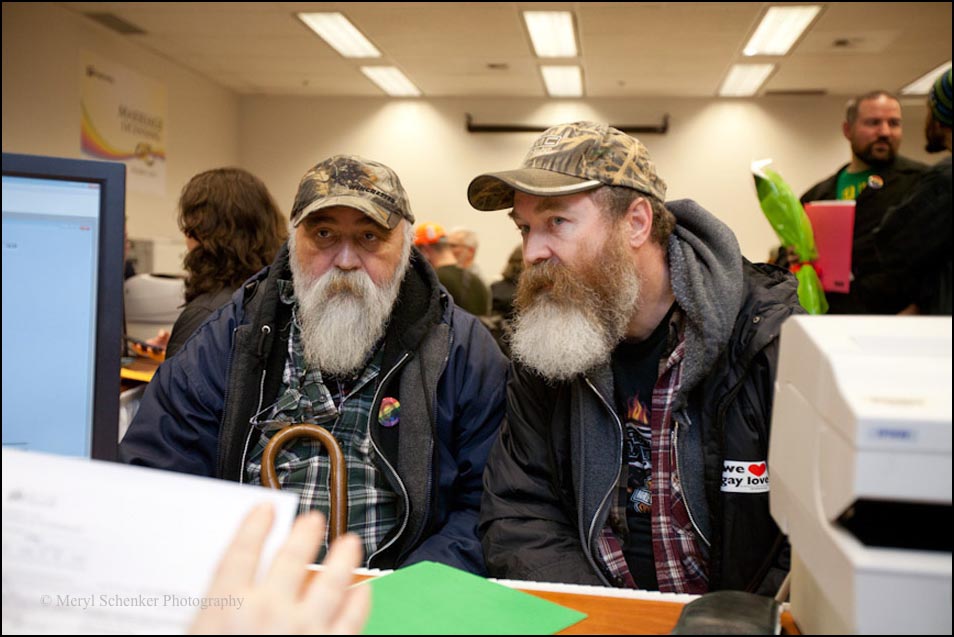
MERYL:
There were a lot of photographers, professional and friends of couples, in a very tight area, trying to document history.
The only challenge while trying to make an image of Larry and Randy was that while they were in the process of speaking with the licensing official, another photographer friend, Bettina Hansen, came over to ask them some questions. Unbeknownst to me, she had photographed them in line earlier using a long lens, and needed their names. She was classy enough to get the information and leave and not “squeeze in.”
TID:
How did you handle and overcome these problems?
MERYL:
I just crossed my fingers and hoped that she would be done asking them her questions by the time they were ready to take the oath. She had a right to be there, so I couldn’t really ask her not to, although I have to admit, it was making me a little nervous. I thought about it asking her to come back after they were finished, but decided not too.
In general, I try and be respectful and not jump in on someone else’s photo. For example, some couples just attract attention. There was a woman wearing a veil, and because that was obviously visual, there were several of us trying to get a photo of her and her fiance getting their marriage license. After a few minutes I walked away and let other photographers “work it”, because I knew that that photo was not going to be unique.
TID:
Now, onto the moment. Can you talk about the moments leading up to the picture and also the actual moment?
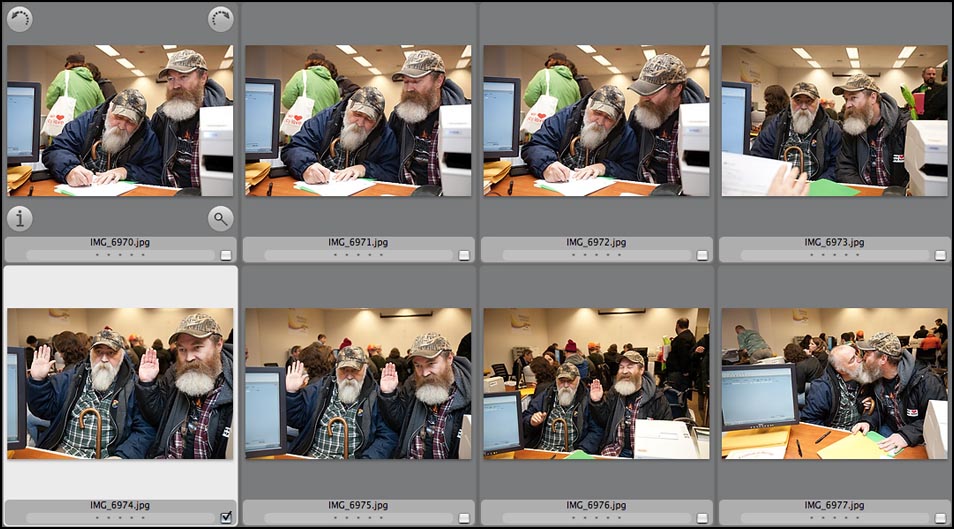
MERYL:
People were being moved in small groups from the downstairs line to the upstairs line (in the hallway outside the elevator) and then into the Recorders office. I was leaving the upstairs area (via elevator) to go downstairs with Jessica and Lisa (to follow them through the rest of the process) when I spotted Randy and Larry waiting in line by the elevator. They stood out because of their long matching beards, their similar look and because Larry was in a wheelchair. I thought to myself, I better try and get back up here and speak to them, they look really interesting.
I went down in the elevator with Jessica and Lisa, I took some more photos and I told Jessica, “I want to get back upstairs and see if I can catch those guys.” Lucky for me, the line hadn’t moved too fast and they hadn’t had their appointment yet.
They were quietly minding their own business when I found them standing in line with everyone else. I don’t remember exactly what I said to them, but we talked, I found them to be charming with their southern accents and mannerisms. I discovered that Larry was only in the wheelchair temporarily. I asked them if I could photograph them as they applied for the license. I think I said something about them looking different. They were so sweet, and I think it tickled them to be asked to be followed, as they didn't see themselves as special. Also, it was around 1:30 a.m. and a lot of the hub bub had died down by then.
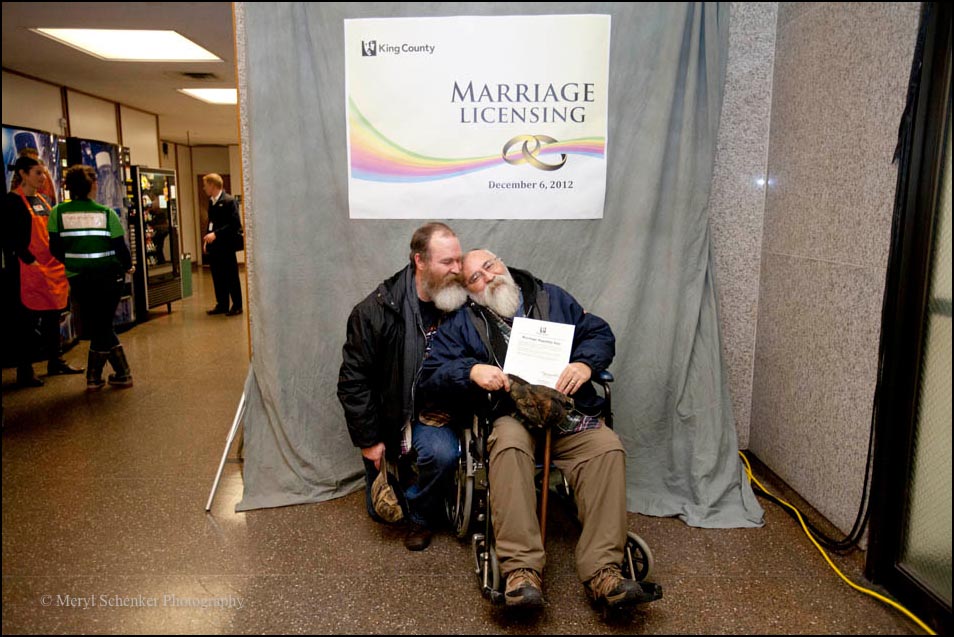
TID:
What surprised you about the moment?
MERYL:
Honestly, nothing. It was a fairly routine event (taking the oath) made special by the people in the photo. Not to be misunderstood, the whole evening was special, but getting a marriage license isn’t typically what one would think of as a particularly photogenic event.
TID:
I'm curious if you have any strategies on how you relate to folks and/or gets them to be natural while you are present. I know you said the situation in the office wasn't too difficult, but still, you are very close to them (physically) in many images, and they seem completely at ease.
MERYL:
I am so glad to hear you say they look completely at ease with me being close. Due to the recent advice of two top-level photo editors, I have been working on getting closer and had that in the back of my mind during both photo opportunities. I've never really thought about how I put people as ease. I think I combine a mixture of talking to them like friends and joking a bit, with being quiet and just letting them concentrate on what they are doing. It 's difficult sometimes because people really like to engage me in conversation. I'm a very honest person, and maybe that comes through. I do think that people can tell when you have a warm heart and good intentions.
In addition, it was a good match of personalities. Not every story is right for every photographer and not every photographer is right for every story (or subject).
TID:
What have you learned about yourself in the process of making images like this?
MERYL:
Remember to trust my instincts.
TID:
Is there anything else you want to add about this experience?
MERYL:
I think some photographers might think that the best picture to be made is the one that is laid out for us by the event organizers. In this case, the private ceremony, with the “chosen” couples. And, those photos were important. But there are images waiting to be made by seeing on our own and not just documenting what is laid before us.
TID:
Could you tell a bit more about how and why you chose to be with them on their wedding day? What did you say or do to get such great images of them in a personal space (the bathroom!)
MERYL:
The night they got their marriage license, (after I took "the" photo), I followed them through the rest of the process. I just liked them and thought they were unique. And I really liked the fact that they weren't looking for attention. At some point, I asked them if I could photograph their wedding. I asked them because it was a historic occasion, and I think many photographers do better concentrating on a specific person (or in this case, couple) than racing around trying to capture everything.
They said yes, although at that point they hadn't confirmed where and when they were actually getting married. We exchanged phone numbers and I called them the next evening, and I told them what happened with their photo going viral.
After that we spoke several times on the phone and exchanged emails, as I kept them informed of what was going on with their photo and helped them navigate through a few requests. They were very grateful to have my perspective since they were never looking for attention, and didn't quite know how to handle it. I never told them what to do, just gave them pros and cons. The phone conversations, and I guess the way I handled myself, built up trust.
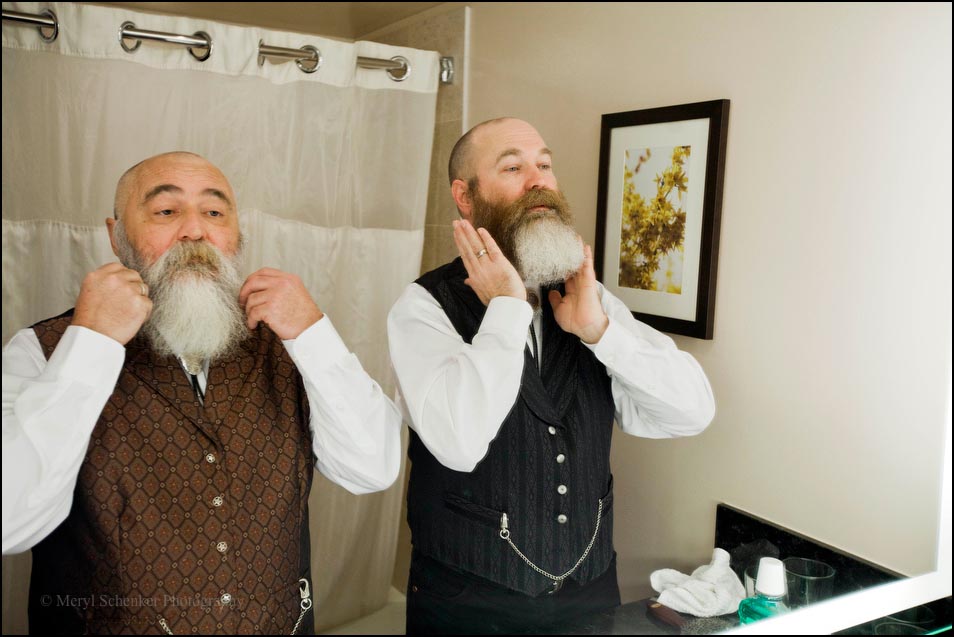
MERYL:
When they decided to go through with the group wedding in the church (they considered postponing because of all the attention), and told me they were going to come to Seattle the night before and stay in a hotel, I asked them if I could meet them at their hotel room and take photos of them getting ready. I figured during a group wedding in a dark church it would be difficult to get intimate photos, and knew spending time with them ahead of time would be best to capture their relationship. Actually, it 's what all wedding photographers do before the wedding, capture the couple getting ready, so it didn't seem like too much of an unusual request. Plus it adheres to the PJ motto, "go early, stay late." Don't know who said that originally, but it's great advice.
The bathroom was tricky because I was standing in the doorway and trying to keep out of the reflection in the mirror. The bathroom was a hotel room bathroom; they live 45 minutes from Seattle, where the wedding took place, so they stayed in a hotel the night before the wedding. I didn't say anything to them except to do what they needed to do to get ready.
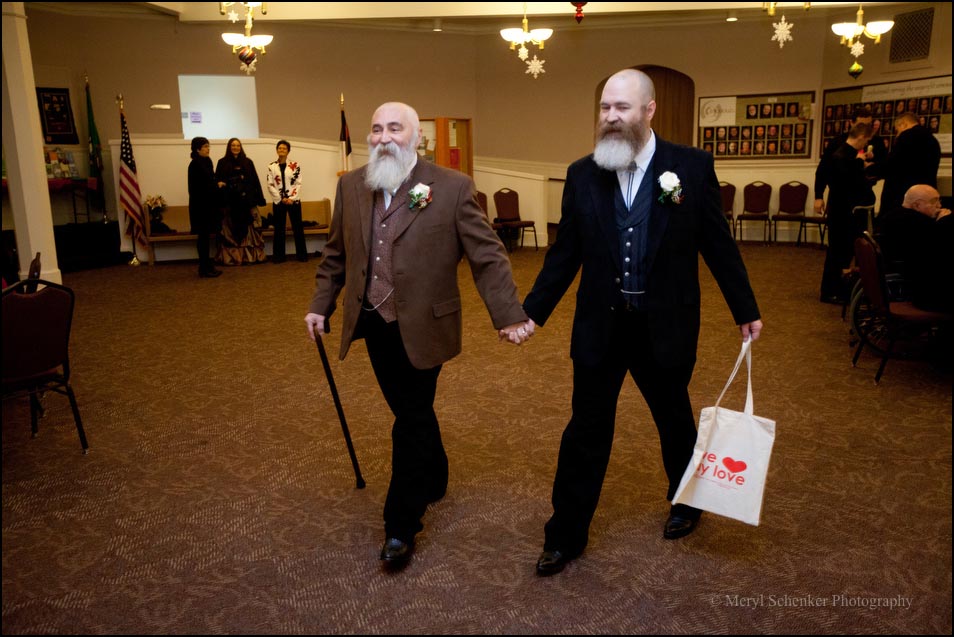
TID:
In conclusion, what advice do you have for photographers?
MERYL:
Three things:
I will pass on the best advice ever given to me by mentor, Bryan Moss who said, "Make images between the moments." That advice has served me very well for the past 17 years.
Occasionally a good photo will drop in your lap, but mostly great photojournalism is just hard work. Push yourself.
Don’t miss the moment, but get away from “the pack.”
:::BIO:::
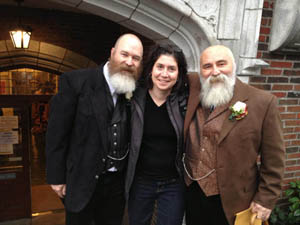
Meryl has been a professional photographer for the past 22 years, twelve of which she spent as a staff photographer at the Seattle Post-Intelligencer newspaper (1996-2009). Since the closure of the newspaper, still based out of Seattle, she has pursued editorial, commercial, documentary and family photography. Ironically, she spends a very limited amount of time covering news.
She holds a B.S. in Biology from S.U.N.Y. (State University of New York) Binghamton. A month after graduating (’86), she headed west (from New York) to intern on the Smithsonian Sea Lion project on San Nicolas Island, and never returned to N.Y. She studied photography (City College of S.F.) and worked in San Francisco for seven years, before leaving for Ohio University's School of Visual Communication. She finally completed her master’s thesis while working at the P-I, and received her degree in 2002. She was lucky enough to hold internships at the Evansville Courier Journal, The San Jose Mercury News and The Seattle Times before settling down.
A few of the organizations that have recognized her work are the Alexia Foundation, the Society of Professional Journalists, and NPPA's Best of Photojournalism. Meryl is truly honored to be asked to contribute to The Image Deconstructed.
Current work in progress includes a multimedia project on a group of people who traveled to Williston, North Dakota looking for work in the oil "boom town." She met them in July 2012, living in a field outside town, and continues to follow them to see if they fulfill their dreams to turn their economic situations around. Her other two passions are fly fishing and traveling.
You can view more of her work here:
EDITOR'S NOTE:
This week's interview was done by Joshua Trujillo, a visual journalist at: www.seattlepi.com with additional help by
TID co-creator Logan Mock-Bunting.
Trujillo was previously interviewed by TID, and you can see his post here: